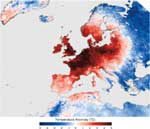In this video Jim Hansen provides a “video abstract” of his latest — and longest — paper, Ice melt, sea level rise and superstorms: evidence from paleoclimate data, climate modeling, and modern observations that 2 °C global warming could be dangerous, published this week after a lengthy period in review. He, and his stellar list of co-authors, have also provided an “abbrievated” version of the paper, which I strongly recommend you read.
My abstract is a bit shorter: fresh water from melting ice sheets in Greenland and Antarctica is beginning to change the way that heat moves around in the global ocean, setting up feedbacks that will melt the ice faster. This in turn will lead to much more rapid sea level rise than suggested in the recent IPCC report, and much bigger temperature contrasts between warm and cold oceans in the North Atlantic and around West Antarctica — which will drive the mid-latitude superstorms of the paper’s title.
Not a pretty prospect. And if you think it’s unlikely, consider this. There are already “cold blobs” in the North Atlantic and off West Antarctica, Atlantic storms are becoming much more vigorous , and there are hints of an acceleration in the rate of sea level rise.
Hansen has been right before. I hope, for all our sakes, that this time he’s not.




 Earlier this month James Hansen wrote a trenchant
Earlier this month James Hansen wrote a trenchant